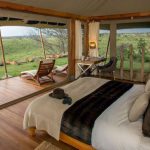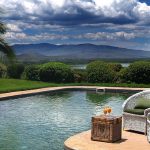
The Ngorongoro Conservation Area is a huge area with a total of 8,288 sq kms. The area includes some other small craters known as Empakai, Olmoti, together with mountains, the archaeological sites of Olduvai Gorge, rolling plains, forests, lakes, dunes and of course Ngorongoro Crater. The highest peak of the area stands at 3,600 mts above the sea level known as mount Lolmalasin. Active volcanoes of mount Oldonyo Lengai is located on the North East side of the Area, Ngorongoro Crater, the first view of it is absolute splendor. The most striking feature, the Eden of Africa, one of the wonders of the world! The Crater has an area of about 260sq Km that is 19 km across. It stands 2,286mt above the sea level, the floor lies about 610mt below the rim. The crater has a spectacular concentration of wildlife. Within the crater there is shallow Soda Lake (Magadi) and flamingos that dwell around the lake which remains dry sometimes. It is the best place to see rhinos throughout the year, the bird life is also rich and the hunting ground for lions, cheetahs and hyenas. Between the Ngorongoro and Serengeti area lies the world’s most important archaeological site the “Olduvai Gorge”. “The cradle of mankind’, where the oldest trace of men and animals were found by the Leakeys. Best Time: Whole year – rainy season in April.
Covering an area of 264 km. sq., this is the largest caldera in the world and has an abundance of wildlife permanently residing on the crater floor. Approaching the crater is a unique experience, the road winds upwards through a beautiful area of montane forests and flowering meadows, before a final bend which then reveals the crater 2,000 ft. below in all its incomparable glory.
A unique ecosystem where one can observe Africa’s predator and prey unfold their daily ritual at close quarters. The crater floor with its grasslands, salt pans and stands of Acacia forest hosts a fascinating diversity of large mammal species




